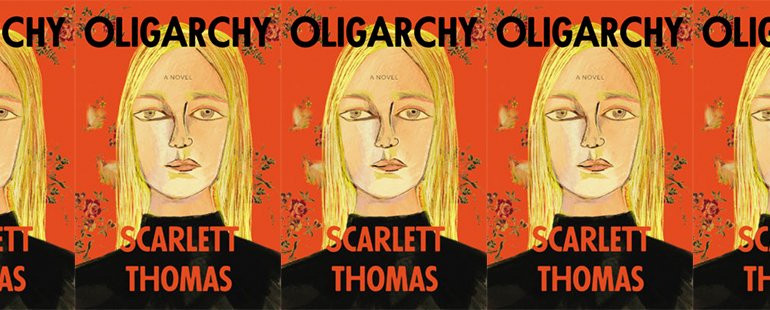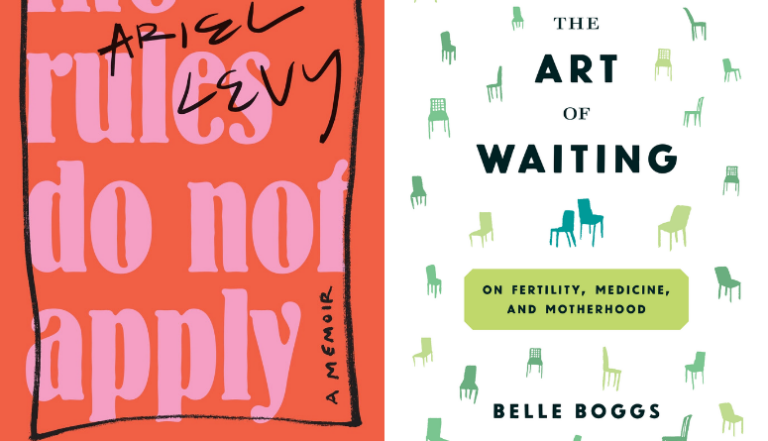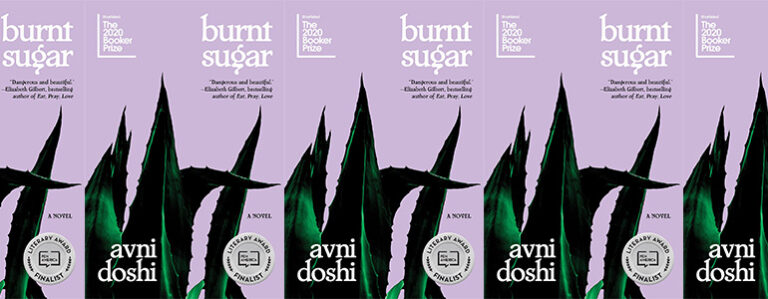The Revealing Cultural Portrayal of Oligarchy

Scarlett Thomas’s Oligarchy, out in the United States this week after initial publication in 2019 in the United Kingdom, is both absurdism and reality pared to its core, just as the girls in the novel pare themselves pound by pound at their no-name, British girls boarding school. They talk about their weight with a collective obsession amplified by the third person narration that blurs the boundaries between their voices, but not their ever-sharpening bodies. The school’s complicity in their eating disorders looms in the background. Equally prominent is the wealthy girls’ constant judgement of the “plebs”; though the presumable protagonist is judged for her new money, money new even to her, she quickly adopts her peers’ careless condescension. As the girls judge what lies beyond their cloister, they restrict their eating so fiercely that they obscure the very world they are trying to best as it falls to pieces around them.
The novel opens with Natasha, the daughter of a Russian oligarch, en route to the second-rate boarding school. In the cab, she feels an adrenaline rush, and then “[t]he useless chemicals in her body swirl like flower petals and then sink into the mysterious darkness of her insides, along with the Diet Coke she had on the plane, and the half lemon, and the one vegan salted caramel chocolate that she hates herself for right now, even though she threw the rest of the box away.” The loveliness of Thomas’s description nearly hides the danger of Tash’s thoughts. When Tash arrives, she laments her “massive thighs” that “look like prize-winning hams,” even though she says she has “the right proportions.” Her critique of herself mirrors that of the beautiful French student Tiffanie, one of the girls Natasha falls in with, whose “tits are little works of art, or possibly craft: two perfect upside-down teacups,” though later Tiffanie starves herself anyway. Beauty is secondary to their tenacious competition to be the thinnest.
At first, this illness seems contained to these girls in their attic dorm, their togetherness negating the need for a group chat since they “are a group that chats anyway, like IRL, like literally all the time, even in bed.” Ominously, Tash notes that “[i]t’s as if they were put [t]here for some deliberate reason, to make them feel different from everyone else: to make them go bad.” They become “rotting apples,” rotting because of how little they eat and how casually cruel they are to the world outside their attic. To be chosen like this is alluring. They are rich and skinny and flaunt their ability to become skinnier through willpower. But we know this willpower is illness, and scrutinizing the skinny and rich is something we are very good at as a culture prone to social media scrolling. The girls do it, too, on their against-the-rules cell phones, and we begin to wonder if it is being done to them deliberately—if the reason they are housed in the attic is so the others—and so we—can watch girls starve themselves until their ribcages become tenebrous.
Just how troubled this school is quickly becomes apparent through Bianca, the skinniest girl in the school. At one point, Tash sees Bianca playing the piano, “her narrow, ravaged body bent like a claw.” Bianca invents games for the girls to play, like “find[ing] the grossest, most calorific meal you can” or “the Fat Ballerina Challenge, where you had to find images of professional dancers and zoom in on their arses or their stomachs or their chins and rank the most gross body parts in order.” She also starts the trend of taking turns creating a diet for all the girls to do each week. During her week, everyone eats cake, except she throws hers up. “[D]ieting is all relative and one of the most effective ones (the Einstein Diet, haha) involves simply making the people around you much, much fatter,” Bianca thinks. Her games make the attic girls into a microcosm of what goes on beyond their walls: the women in town doing Weight Watchers, their Instagram feeds, YouTubers and their hours of exercise videos. As Bianca erases her body bit by bit, she feels like “a weightless comet blazing through the dark sky,” while others see her as “a little bird that can’t yet fly.” None of the girls say anything. The school cook rolls her eyes at their diets. Only the headmaster addresses Bianca’s macilence, summoning Bianca and girls like her to his home for “improving’ activities”—and then she is dead.
Bianca’s death is ambiguous—she dies by drowning though the severity of her anorexia is undeniable—but even her death doesn’t give the girls pause. If anything, the girls’ eating disorders explode, exacerbated by the staff’s slapdash programming that inspires the girls when they should be giving them the help they need. After a parent criticizes the school’s punishments of early morning laps and runs, the girls must instead listen to the headmaster read Great Expectations; they become enamored with Estella, “a beautiful, thin, rich girl . . . who never eats and who lives in a house full of cobwebs.” She’s “a girl who delights in making a boy cry . . . [a]nd makes him eat, but does not ever eat herself.” Later, the biology teacher teaches them how to measure their body fat with calipers. The school brings in two counselors, one of whom Tash describes as having “the eyes of a lifeguard who lets people drown,” as well as a YouTube star who is said to have “recovered” from an eating disorder but who very much seems to the girls to have not. Anastasia wears a necklace with her nickname, “Ana,” which Natasha finds “troubling” given that “ana” is shorthand for anorexia, like the Pro Ana WeChat group Bianca joined before her death. Anastasia bares her midriff and talks about having not eaten ice cream since she was nine years old, and not being comfortable with things like pizza and hot chocolate even now. “If this is the face of anorexia,” the girls reflect, “pretty much everyone wants in.” That the school has brought in a YouTube celebrity, that Estella is immortalized in fiction, that they know how to thin their bodies and how to measure this thinness is thrilling. Here, the narrative begins to shift: what was unsurprising—eating disorders at a girls’ school—becomes more novel as the school comes to stand in for a culture that fosters this illness among girls. The school—the headmaster—seems to want them to starve. The school isn’t just inactive in responding to the crisis—it actively feeds the illness. After the YouTube star’s talk, one of the “fat” girls forgoes her dessert for the first time and finds doing so “beautiful, and awful, and very, very simple.” The second bloom of eating disorders begins.
The girls also intertwine class and weight in another revealing element of the book: “plebs” are almost always fat and if they are skinny they’re still far from the standards of beauty—or body, at least—that these girls starve for. The girls are harsh and hyperbolic in their descriptions of villagers: “They wear clothes from Sports Direct that smell of cheap chemicals and their breath is all Special Sauce bubblegum vape. Everyone, literally everyone, who lives in this town is fat. The only people who are not fat look like pleb versions of Bianca and have pushchairs full of children, long, stringy hair and thousands of piercings.” Thinness, to the girls, only counts when it’s paired with expensive clothes and boots and bracelets. Unlike her classmates, however, Tash is familiar with plebs—she was one once. Back home, she would hear “[p]lebs’ voices all the time through the walls of her mother’s apartment, screaming at each other. The dull thump of marriage and babies and the middle of the month.” Tash loathes her background, and instead, like a lifesaver, she wields her black Amex card and gold and diamonds on her wrist and the right kind of thinness.
As the eating disorders and judgement rage on, Natasha meets her Aunt Sonja, her father’s wealthy sister, for the first time. Beautiful Aunt Sonja takes Natasha under her wing and spouts advice about beauty and food and thinness. “Keep your beauty,” Aunt Sonja says early on. “Do everything you can to keep your beauty. But also care for your fragile soul.” Initially, her aunt is as exacting on herself as the girls are, serving poached fish and brown rice and a vegetable, and for Christmas a chocolate mousse made only of egg and bitter chocolate. But as the year wears on, Aunt Sonja has a change of heart. They have an extravagant meal, she gives Natasha a “basic feminist grounding,” and she helps Natasha observe that not all famous women are skinny. “I’m not anorexic,” Natasha tells her aunt. “Some girls at school obviously are, and, like, it’s got really out of hand lately, but it’s just not me. I even tried to catch anorexia because I wanted to be thin . . . But my brain just isn’t wired that way.” Aunt Sonja responds, “Good. I can see that. But mine is.” For the first time, Natasha talks honestly with her aunt, who talks honestly back. She is touched by her aunt’s gesture and begins to pull away from the eating disorders that consume them.
During her last trip to her aunt’s, Aunt Sonja ultimately provides Natasha with the lynchpin for the novel’s denouement, revealing in the process that the family’s wealth comes from scams. Natasha learns what her aunt does for work—namely phishing—and it doesn’t take long for Natasha to figure out how to do it, too. In the process, she brings her second-rate boarding school crumbling down—a necessary step to save the starving girls trapped within. Rachel, who emerges as the next girl who is the best at starving herself after Bianca’s death, is now favored by the headmaster and therefore most at risk. “No one wants to admit it, because it is so fucked up, but there is something truly compelling in her frail boniness. It’s not so great when she’s naked, that’s true: but in clothes she looks the fucking bomb,” the girls observe. “Maybe that’s why no one does anything.” Without Tasha’s intervention, it’s clear that Rachel would have gone the same way as Bianca. What would presumably be troubling—a phishing scam—then becomes lifesaving, when Natasha makes damning discoveries. In a place where girls are allowed, encouraged even, to starve, they are saved by their own ingenuity—one scam negates another.
Even as they compete for thinness, their girlish comradery is never lost. When they discover a slam book from 1988, they decide to make one themselves. They tease an attractive male teacher together. They make up nicknames and speak bits of French and copy Tiffanie’s penchant to Frenchify infinitive endings so that words like “going” are pronounced “go-ange.” They listen to pop artists and consistently refer to a girl not in their interior circle as “Becky with the bad hair.” They contrive a silly scheme for naming their personal style each season by pairing something random with an actual trend that season: “cocktail safari, or mermaid outlaw, or . . . cowgirl strip-club.” Their antics are unmistakably schoolgirl, the result of an experience intensely shared, and their playfulness makes clear that their bonds trump their desire to be the thinnest. When news of the schools’ out of control eating disorder epidemic breaks, a detective tells Tash, “But no one really notices schoolgirls with eating disorders. No one puts them together.” Eating disorders, the detective points out, are as unremarkable as the girls’ fashion and way of speaking to each other, part of the language of their privilege and place. The villagers that the girls so denigrate view the eating disorders as a systemic problem at the school; Bianca’s twin brother blames the school for killing her. But even when their illness is lethal, the alarm isn’t raised on the outside. It takes the phishing scam from the daughter of a Russian oligarch to save them, and, in the end, the girls save themselves not so much from the illness or each other as they do from the place and culture that encourages them to be ill.


